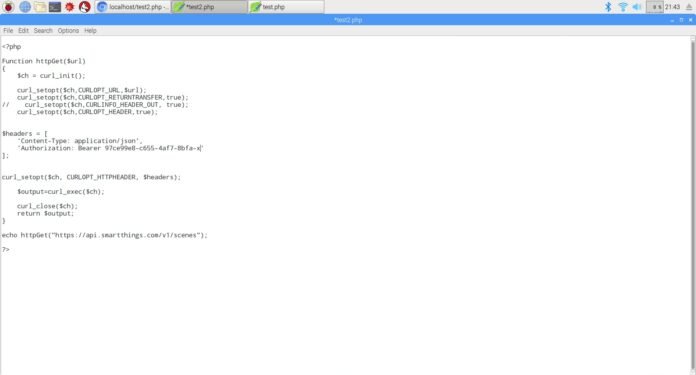Unlock the endless possibilities of your SmartThings devices with the power of toggle commands! If you’re looking for a seamless way to control your smart home gadgets, then you’ve come to the right place. In this blog post, We will dive deep into the world of SmartThings Device URL API Toggle Command and show you how to harness its full potential. Whether you’re a tech-savvy guru or just starting out on your smart home journey, this step-by-step guide will empower you to take charge and make your life easier than ever before. So buckle up, get ready for some serious automation magic, and let’s explore the ins and outs of this incredible feature together!
SmartThings Device URL API Toggle Command: Explained
So, what exactly is the SmartThings Device URL API Toggle Command? Well, it’s a powerful tool that allows you to control your smart devices using simple HTTP requests. With this command, you can toggle the state of your devices on or off with just a few lines of code. The beauty of this feature lies in its simplicity and versatility.
By utilizing the SmartThings Device URL API Toggle Command, you can integrate your smart devices into various applications and platforms seamlessly. Whether you want to create custom automation routines, build a personalized dashboard for controlling all your gadgets, or even develop complex voice commands through integrations like Amazon Alexa or Google Assistant – the possibilities are truly endless.
One key advantage of using this command is its compatibility with a wide range of devices. From lights and thermostats to locks and sensors, if it’s connected to your SmartThings hub, chances are you’ll be able to control it using the toggle command.
To use the toggle command effectively, all you need is an understanding of how HTTP requests work. By sending specific GET or POST requests along with device-specific parameters such as device ID or capability ID, you can easily turn on/off any supported function within seconds.
The ease-of-use doesn’t stop there! You have flexibility in choosing different programming languages that suit your expertise when interacting with SmartThings’ APIs. Whether you’re comfortable working with Python scripts or prefer JavaScript libraries like Node.js – there’s no shortage options available.
SmartThings Device URL API Toggle Command: Step-by-Step Guide
Are you ready to take control of your SmartThings devices with just a few lines of code? The SmartThings Device URL API Toggle Command is here to make your life easier. In this step-by-step guide, we will walk you through the process of using this powerful command.
Step 1: Understand the basics
Before diving into the implementation, it’s important to have a clear understanding of how the SmartThings Device URL API works. Familiarize yourself with its capabilities and limitations to ensure a smooth experience.
Step 2: Set up your development environment
To begin, make sure you have all the necessary tools in place. Install any required software or libraries and create an account on the SmartThings Developer Portal if you haven’t done so already.
Step 3: Authenticate your application
To access and control your devices through the API, you’ll need to authenticate your application. Follow the provided instructions to obtain an access token that will grant you permission to interact with your devices.
Step 4: Identify target device(s)
Next, determine which device(s) you want to toggle using the API command. Retrieve their device IDs or other identifiers from within your SmartThings account.
Step 5: Craft and send HTTP requests
Using a programming language of your choice, construct HTTP requests that include relevant information such as endpoint URLs and headers. Make sure to specify the appropriate method (POST or PUT) for toggling commands.
Step 6: Test and troubleshoot
Now comes the exciting part – testing! Send out test requests to verify that everything is working as expected. If any issues arise during this process, refer back to documentation or seek help from online communities for troubleshooting assistance.
SmartThings Device URL API Toggle Command: Tips and Tricks
1. Test the command before implementing it: Before you start using the SmartThings Device URL API Toggle Command, it’s a good idea to test it on a single device to ensure that everything is working as expected. This will help you avoid any potential issues or errors when applying the command to multiple devices.
2. Keep track of device states: To make the most out of the toggle command, keep track of your device states. By knowing whether a device is currently on or off, you can use the toggle command effectively to switch its state accordingly.
3. Automate with routines and scenes: Combine the power of SmartThings routines and scenes with the toggle command for enhanced automation capabilities. Create custom routines that trigger specific actions based on certain conditions, and include toggling commands within these routines for seamless control over your devices.
4. Use descriptive names for devices: When naming your devices in SmartThings, choose names that are easy to remember and understand at a glance. This will make it easier to identify each device when issuing toggle commands through URLs.
5. Include error checking in your code: While using the SmartThings Device URL API Toggle Command can simplify your home automation setup, it’s always wise to include error checking in your code implementation. This will help catch any unexpected errors or failures during execution.
SmartThings Device URL API Toggle Command: Common Issues and Solutions
Having trouble with the SmartThings Device URL API Toggle command? Don’t worry, you’re not alone. Many users encounter various issues when trying to use this command, but fortunately, there are solutions available.
One common problem is when the toggle command doesn’t work as expected. This could be due to incorrect syntax or a mismatch between the device capabilities and the command being sent. Double-check your code to ensure accuracy and compatibility.
Another issue that users often face is connectivity problems. If your device isn’t responding or showing up in the SmartThings app, check your network connection first. It’s also worth verifying if your devices are properly paired and authorized within the SmartThings ecosystem.
Sometimes, inconsistencies in device status can cause confusion. If you’re experiencing discrepancies between physical states and what’s displayed on-screen, try refreshing or restarting both the device and app. In some cases, a firmware update may be necessary to resolve these conflicts.
Furthermore, troubleshooting errors related to authentication token expiration or invalid permissions might require reauthorizing access for better functionality of the API commands.
Remember that integrating different devices from various manufacturers can introduce additional complexities into your setup process—compatibility issues arise more commonly than we’d like! Check for firmware updates regularly for both your hub/controller as well as connected devices—the manufacturer usually provides these updates with fixes for known bugs.
When encountering difficulties with complex automation scenarios involving multiple devices simultaneously toggling state changes through APIs across different platforms/services—debugging becomes increasingly intricate!
As always, if you’re struggling to find a solution on your own don’t hesitate to reach out to support forums or consult online documentation provided by Samsung—it’s an invaluable resource packed with troubleshooting guides tailored specifically towards resolving common issues faced by users utilizing their SmartThings platform integrations extensively!
Stay tuned for our next blog post where we’ll explore best practices for using the SmartThings Device URL API Toggle command effectively.
SmartThings Device URL API Toggle Command: Best Practices
When it comes to using the SmartThings Device URL API Toggle Command, there are a few best practices that can help you make the most out of this powerful feature. Here are some tips to keep in mind:
1. Use descriptive names for your devices: When naming your devices, be sure to choose names that accurately describe what they control. This will make it easier for you to remember and toggle them using the Device URL API.
2. Organize your devices into groups: If you have multiple devices connected to your SmartThings hub, consider organizing them into groups based on their location or functionality. This will allow you to toggle multiple devices at once by simply sending a command to the group’s URL.
3. Test before deploying: Before integrating the Device URL API Toggle Command into any automation or third-party application, it’s important to thoroughly test its functionality and reliability. Make sure all your devices respond correctly and consistently before relying on them for critical tasks.
4. Implement security measures: Since the Device URL API allows external access to your SmartThings hub, it’s crucial to implement proper security measures such as strong passwords and two-factor authentication.
5. Regularly update firmware and apps: To ensure optimal performance and compatibility with the Device URL API, regularly check for firmware updates for both your device hardware and SmartThings app.
Conclusion
In this article, we have explored the SmartThings Device URL API Toggle Command and learned how to use it effectively. By leveraging this powerful command, you can easily control your SmartThings devices through external applications or services.
We provided a step-by-step guide on how to implement the toggle command in your projects, ensuring seamless integration and efficient device management. Additionally, we shared some tips and tricks to help you optimize your usage of the toggle command for a smoother experience.
While using the SmartThings Device URL API Toggle Command, you may encounter certain issues. However, with our troubleshooting tips and solutions, you will be able to overcome these challenges quickly and continue enjoying the benefits of controlling your devices remotely.
To make the most out of this feature, it is important to follow best practices such as proper error handling and authentication methods. This will ensure secure communication between your application or service and SmartThings devices.
Now that you are equipped with knowledge about the SmartThings Device URL API Toggle Command, go ahead and explore its possibilities! Take advantage of its capabilities to create innovative solutions that enhance automation in your smart home setup.

